Archives
Can Your Machete Hack it?

Sometimes I realize it’s easier to make the tool I need than to spend hours or days trying to find one that’s already
just the way I want it.
This was true once again when clearing a trail in the woods- neither a machete or
an axe was up to the task.
The scraggly trees we have in North Texas can be quite resilient when being
cut. In fact- there aren’t many trees in Texas that give up their limbs easily.
Everything in the Lone Star State seems to be impossibly tough!
A store bought machete just bent and deflected off most branches even though
it was freshly sharpened, and the axe was nearly impossible to aim at smaller
limbs. The blunt chopping blade of the axe would just bend the limbs out of the
way and barely scratch them.
There are some really nice machetes from knife companies that would probably
work better, but sometimes it’s important to know how to make your own.
Especially if there are no stores to go to, or inflation has made buying one out of
the question. These important skills can be put towards making any type of blade
you may need.
Metalworking is an art that is learned over time. I’m by no means the best metal
worker around, far from it. I just practice and take my time when working with
metal.
First you’ll need metal to make the blade out of. Since your making a sharpened
blade you’ll want hardened steel. Old saw blades from sawmills are great for
making knife blades. They can be found at flea markets anywhere in the country.
There are other places you can scavenge hardened steel from such as
lawnmower blades and circular saw blades. New hardened steel sheet can also
be purchased at most metal supply shops. I’ve even seen guys forge amazingly
strong knife blades out of railroad spikes!
After you’ve picked out your metal you’ll need to cut it. For hardened steel a good
metal band saw or plasma cutter works well. Since I have neither of those, a
trusty cutting torch is my go-to metal cutter.
Take the cutting slow so you don’t over heat the metal. Just a little at a time.
Overheating causes warping and can alter the molecular structure of the steel
making it soft and unable to hold a good edge.
(Note On Heat Treating)
When you’re making a cutting blade, the hardness of the metal is important
to being able to hold an edge. By starting with a hardened steel I can skip
heat treating and tempering- but I’m also not making a “perfect” blade. Heat
treating and tempering can be a seriously dangerous process. Leave that to the
professionals until you’re completely ready!
Cut the blade out larger than you want it so you can grind it down to the size and
shape you want. This was any metal I overheated while cutting will get ground
away. You can overheat while grinding as well so use light pressure and grind off
just a little at a time.
Shaping your blade profile is a whole ‘nother art form that takes time and
experience. I did a little research and decided on a profile that didn’t have to
extreme of an angle, if I need more cutting power I can always profile the cutting
edge more. The profile is how angled the cutting edge of your blade is. This
makes the edge longer and thinner (slicing) or more blunt (chopping).
See the diagram for a quick visual:
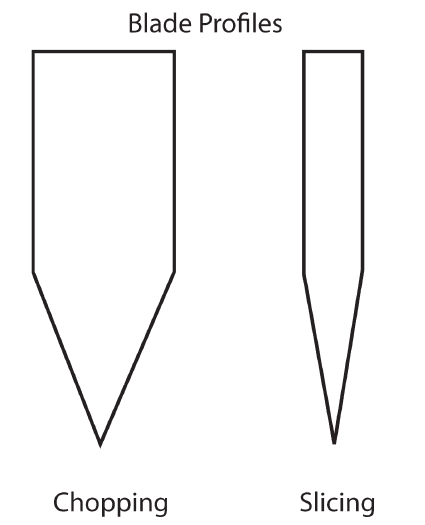
To profile the blade I started with an angle grinder while I had my blade locked
into a table mounted vice. Then I moved to a bicycle pedal style grinder stone.
I like this machine because I feel close to the metal, and it’s more accurate
because it doesn’t chew into the metal near as quickly.
You can do this with many different types of grinders, many use a bench-
mounted grinder, and people who make large amounts of blades like to use a
metal working belt sander.
When the blade edge is contoured close to how you want it- finish the edge with
a good quality file, followed by sharpening stones and high quality sand paper. I
start with a tougher grit and move up to a fine grit until it’s super sharp and highly
polished.
After the blade is done, it’s time to put a handle on it. For my project I chose an
old axe handle. I wanted to have plenty of reach, and be able to get both hands
behind a strong swing. To do this I drilled 2 holes through the handle and the
blade’s handle or tang area. Then I inserted two bolts with nuts and trimmed to
length.
There are better fasteners that you can get at the hardware store for this. If it’s
a handle you’ll be holding onto its important to inset the mounting hardware so
it sits flush. There should be tons of videos on Youtube to show how to make a
nice knife handle. But mine’s purely utilitarian.
It’s a good idea to practice tool making. You never know when you’ll have to rely
on your own ability to make what you need. If you don’t have all the tools for your
project ask someone to help. Metal shops can cut out the blade shape for you
and drill the holes if your equipment isn’t durable enough.
My first attempts at blade making didn’t go very well. It took persistence and
experience before I could turn out anything decent, but eventually I got it nailed down.
Check this out and see what one swing did to a tree limb (golf ball added for size reference):
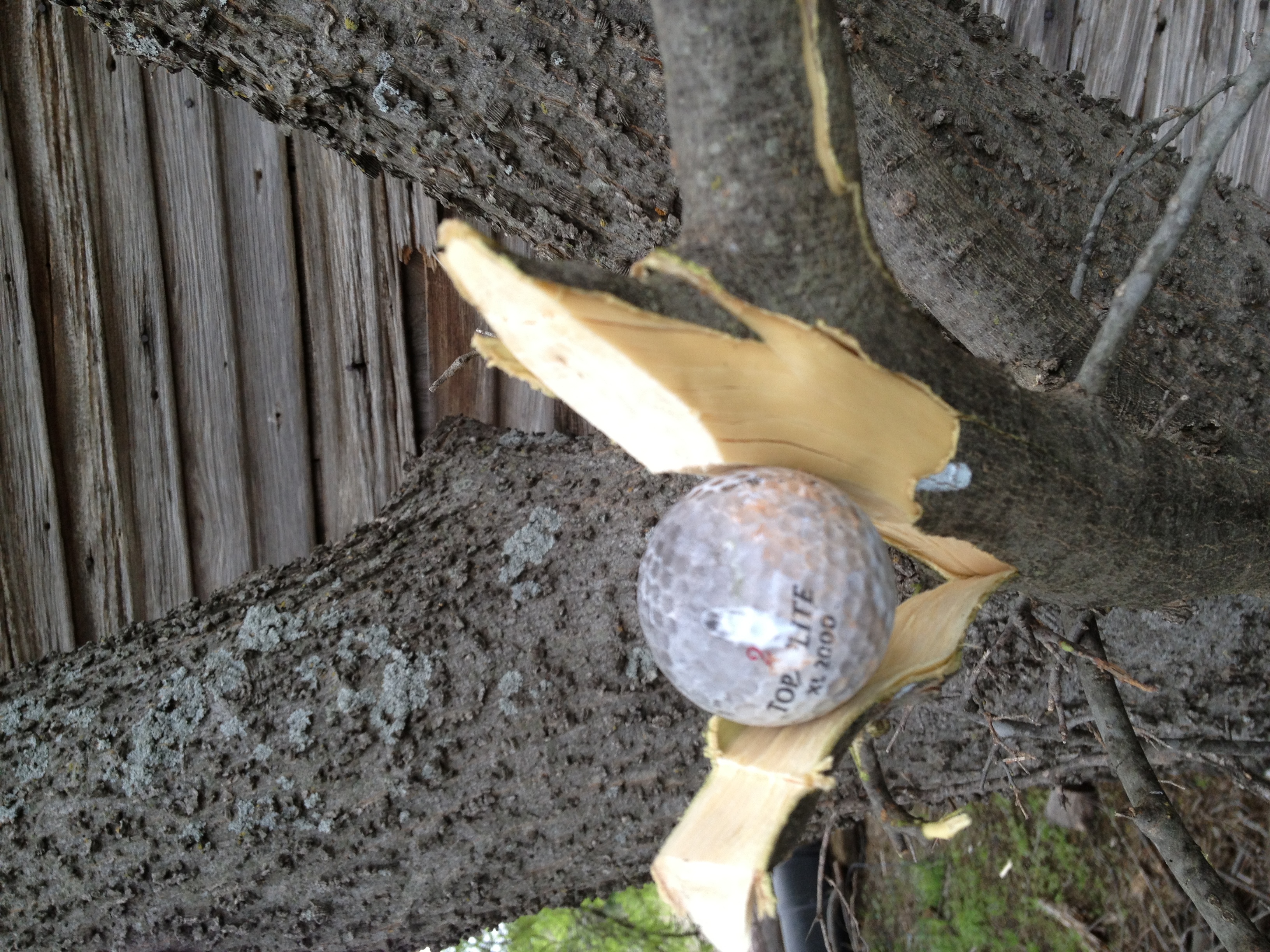
Have fun with it and show us your creations.
We’d love to see what your imagination dreams up.
Kabar BK&T Machax Knife Review
Swiss Army Knife – Good or Gold?
Benchmade HK Feint Fixed Blade Knife Review
-

 Do It Yourself7 months ago
Do It Yourself7 months agoParacord Projects | 36 Cool Paracord Ideas For Your Paracord Survival Projects
-

 Do It Yourself9 months ago
Do It Yourself9 months agoHow To Make Paracord Survival Bracelets | DIY Survival Prepping
-

 Do It Yourself9 months ago
Do It Yourself9 months ago21 Home Remedies For Toothache Pain Relief
-

 Do It Yourself9 months ago
Do It Yourself9 months agoSurvival DIY: How To Melt Aluminum Cans For Casting
-

 Exports8 months ago
Exports8 months agoAre Switchblades Legal? Knife Laws By State

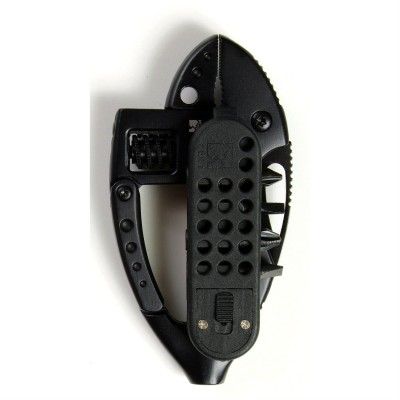


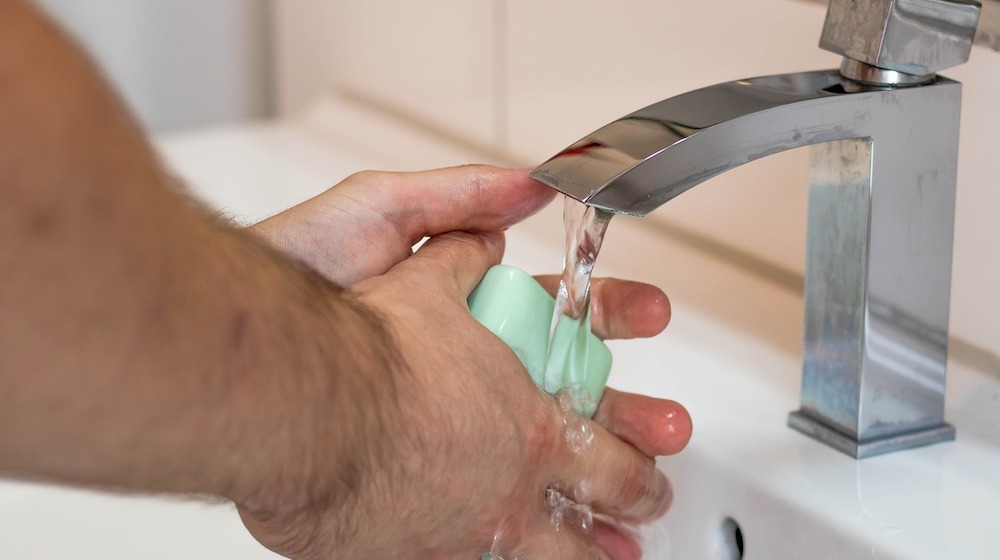
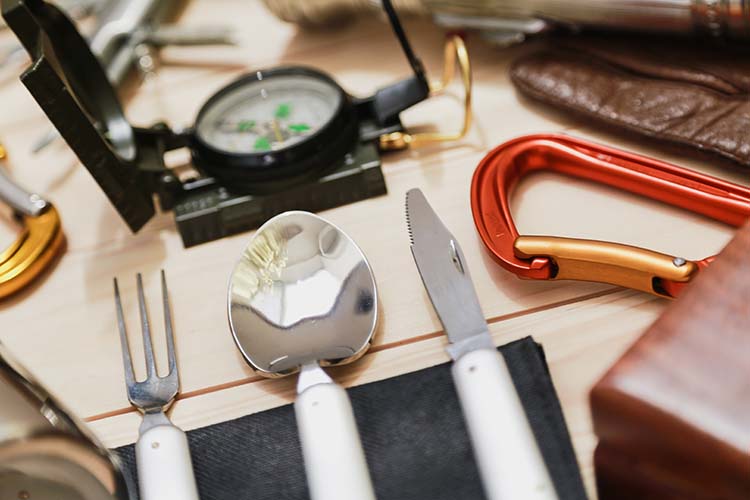
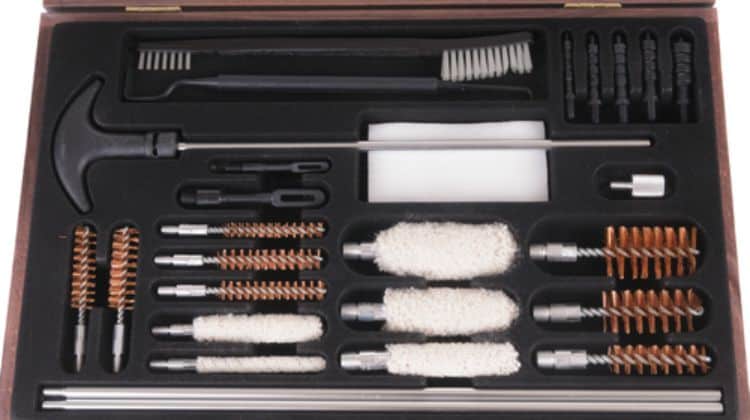

Donald
May 6, 2013 at 8:23 AM
What you have made is a very common brush hook used by surveyors for years
Steve Lindhurst
May 6, 2013 at 10:37 PM
Donald, you REALLY stole my thunder. I WAS going to say; “Or you could just buy a brush hook.” I used to work on a survey team in the “jungles” of Lower Alabama (LA).
PUNISHER
November 7, 2013 at 7:48 PM
I HAVE MADE MY OWN KNIVES WITH A HACKSAW AND A FILE. I MADE A THICK BLADE MACHETE FROM TITANIUM. (WORKED IN AVIATION). THE TANG TO THE TIP WAS 1/4 ‘ THICK. USED MICARTA FOR A HANDEL. TAKES A WHILE TO GET A SHARP EDGE WITH TITANIUM, BUT USING A SHAVING FILE FOR THE EDGE GAVE IT A PERFECT SMOOTH RAZOR SHARP EDGE. FROM END TO END IT’S 14″. THE BLADE WAS 7-1/2″LONG AND WOULD CHOP DOWN A 6″ DIAMETER TREE LIMB. IT HAD A TANTO TIP, GOOD FOR JABBING INTO SMALL BRANCHES OF WOOD TO SPLIT THEM. BEST PART. IT HOLDS THAT RAZOR SHARP EDGE LONGER THAN ANY OTHER METAL. IT’S LIGHT WEIGHT, BUT STRONG AND DURABLE.
willowa
May 6, 2013 at 9:56 AM
You’re right, the ‘average’ machete is not very good. They are often too long (except for cutting sugar cane, which most of us will never need to do), too thin, etc. The best machete I have ever owned is thicker and shorter, not rounded, but has something of a point, much like the one you made. The one I found was made for the French army to use in Senegal. After leaving the first one behind accidentally, once, when I moved, it took me years to find another, but finally did. I guess I didn’t think myself handy enough to try to made one. Thanks for the good article.
JAK
May 6, 2013 at 9:10 PM
Truper makes a ditch blank blade very similar to this and it works great on thick brush and snakes.
John Barrett
May 6, 2013 at 10:16 AM
Try an old-fashioned corn knife. These used to be available in every hardware store, but you have to look for them now. They look like a tapered machete, with the handle end being lighter, and the other end being much heavier than a machete, and squared off.
As the name implies, they were used to cut corn stalks, back before the days of mechanization. Cutting dried corn stalks all day without the added weight on the end would have been almost impossible
Corn knives work well on Osage Orange hedge trees, which a Popular Science article in the 1970s classified as the hardest, densest, wood in either North or South America.
HJ Lamb
May 6, 2013 at 12:07 PM
Nice tool! The best machette type blade I ever owned was a Philippine bolo knife made from an old US Army jeep leaf spring and handled with a nara-wood handle. I bought it from a negrito tracker at “snake school” aka jungle survival course at Clark AB just before heading to ‘nam! Used it for a long time and even jungle rot n rust didn’t defeat it. Could say I lost it in a crap game, but that would be a lie! When I returned state side, I settled down to a 4 year instructor hitch at Sheppard AB in northcentral Texas. It could easily handle most mesquite and other hardwoods quite handily. Good balance and heavy weight forward for good chopping results. About the only wood that really challenged it was desert ironwood! Also made a handy-dandy lawn edging tool and overall gardening tool. Left it out on my porch one evening along with some other more expensive tools and the next AM it was the only tool missing. Don’t know who got it but they got the best of the tools there! Wish I still had it tho and that was back in 1975! A good knife is like a good friend, always available when you need it, can trust and rely on it and will keep you alive!
Elk Horn
May 6, 2013 at 1:29 PM
Brush Hook it is. Does someone still make these. I have one picked up 60 years ago. Heavier than an axe and wicked.
Dan
May 6, 2013 at 4:20 PM
Cold steel sells some really good machetes in all kinds of patterns including one very similar to this one at reasonable prices. I had a Kukri style called the heavy terrain chopper that worked very well for years but it was in my truck when it got stolen.
Steve Lindhurst
May 6, 2013 at 10:41 PM
I bought one for my lovely little wifey at Lowes about 5 years ago. Or any surveyor outfitter could probably get you one. I paid about $35 -$40 for the one at Lowes. Wasn’t any different than the one I used to swing in the “jungle”.
LARRY
May 6, 2013 at 4:19 PM
IF YOU DON’T HAVE ACCESS TO A FORGE ,THE ARMY /NAVY SURPLUS HAS EVERY TOOL FOR BRUSH AND TREE FALLING KNOWN TO MAN!
ANY GOOD FARM CATALOG IS ANOTHER GOOD SOURCE OF SHEARS WITH STEEL HANDLES ETC.
ONE WAY TO HANDLE BRUSH IS WITH A LAWN EDGER TURNED FLAT FITTED WITH A GOOD RIP SAW BLADE . THIS IS A TWO OR THREE MAN OPERATION DUE TO THE PRESSURE ON THE BLADE AND CLEARING THE AREA OF CUT MATERIAL.
Dale
May 6, 2013 at 5:08 PM
Skip rotary mower blades ,they’re soft so they don’t shatter when you hit a rock. Try a truck repair for a broken leaf spring. It’ll be a bear to shape but will hold an edge ’till judgement day.
TpC
May 6, 2013 at 7:06 PM
I found that taking along Edward Scissorhands, the Tazmanian Devil, and a good gas powered chainsaw usually does the trick.
Steve Lindhurst
May 6, 2013 at 10:44 PM
Yeah, old Eddie, he helps out around here sometimes seeing as me and the wifey are gettin’ a little old and decrepit. He’s quick!
Chuck
May 6, 2013 at 7:53 PM
Gerber is selling a brush hook and the Japanese also have a well designed brush hook. The Gerber brush hook is sold by almost any outdoors mail order house and many other places. I suspect you can find it at Walliworld and maybe even K-Mart.
Finding a Japanese brush hook is a little more difficult. The only mail order site for Japanese tools was bought by a hardware company and taken off line, so outside of a city with a major Japanese population, ie., SFran, LA, New York, Seattle, Portland, I don’t know where you might find it. Because farm mechanization came late to Japan, they have some really nice hand tools and because they expect the tools to be passed down from generation to generation, most of them are real quality.
Nick
May 6, 2013 at 9:06 PM
Thank ya’ll for all the great comments. Good point Dale about the lawn mower blades! I always heat treated/ harden the rotary cutter blade metal. (Oversight on my part). I like the gerber products but still find them thinner than I’d like.
Patti
May 11, 2013 at 11:28 PM
This is great info. I myself do not have the skills to make tools. But it is a reminder that most of us do have skills to re-purpose something old, take scraps and make something useful. Redesign a tool to better suit our own special needs. My Dad was a tool & dye maker from the 1930’s until he retired in the 1970’s. He was also a full time farmer. LOL he made many add on parts to farm equipment. And really different little tools and gadgets that made life a little easier. All with just an 8th grade education. And I am not putting down the folks with a college education, but when everyone else had tried and failed to fix a problem at the factory they went to my dad, the old guy. He could figure it out and fix anything. So I do very much admire all the folks who work with metal, make their own tools, adjust, re-purpose, and make it work. You have a valuable talent/skill.
Nick
May 13, 2013 at 2:58 PM
Thank You Patti! There’s no replacement for hands on experience and patience.
Dew
May 12, 2013 at 3:49 PM
Not trying to sound like a know-it-all, but… You say it was hard to swing the ax at smaller limbs, and the blunt edge didn’t cut them. You need practice with your ax. And you need to sharpen it as well. An ax should be sharp enough to shave hair off your arm.
And the diagrams of your cutting edges are wrong. A chopping tool should have a thin, convex edge. Not a fat, straight one. This enables the edge to stay razor sharp, but still stay strong and resist folding over.
Nick
May 13, 2013 at 2:57 PM
Hey Dew, It seems that edges used for different things are greatly debated. I’ve found that “chopping” edges are more blunt because they need to hold up over longer periods of time. Having this thicker metal keeps the tool usable longer and helps stave off chips and bad pitting. As for the axe and limbs, it’s a small surface area, the cutting edge on an axe is usually about 4 inches. With the AxeChete I’ve got a full 12 inches of blade to catch that limb with- especially when there are many limbs to cut in one swing. Each of us has a preferred tool, and type of tool that works best for their needs. By all means get out there and experiment with what works best for you.
Jesse
October 24, 2013 at 8:42 PM
You stated your axe troubles right off the bat, “blunt” shouldn’t be a word ever used to describe the edge on an axe. Up here in northern Michigan my axe is always at my side as I run the trapline and in all my other adventures. It doesn’t have to be razor sharp, I use a file to get the edge close and then use a medium stone to put a nice sticky edge on it. A convex edge will hold sharp in even the toughest of wood. I have a machete for cutting cattails and light brush but if I could only chose one I will take my axe every time.
Pingback: Machete: A Beginner’s Guide | Primitive technology
Pingback: 4 Great Ways On How To Use an Axe – The Self-Sufficient Life
Pingback: How to Use an Axe | Bushcraft Axe Skills - Primal Survival
Pingback: How to Use an Axe | Bushcraft Axe Skills - Survivalnomics
Pingback: How to Use an Axe | Bushcraft Axe Skills - Cooking in Quarantine
Pingback: How to Use an Axe | Bushcraft Axe Skills – Bulletproof Survivors
Pingback: Survival Machete | Top 10 Best Machetes for Survival 2022 - Cooking in Quarantine
Pingback: Survival Machete | Top 10 Best Machetes for Survival 2022 – Sprent Brass
Pingback: Survival Machete | Top 10 Best Machetes for Survival 2022 – Bulletproof Survivors